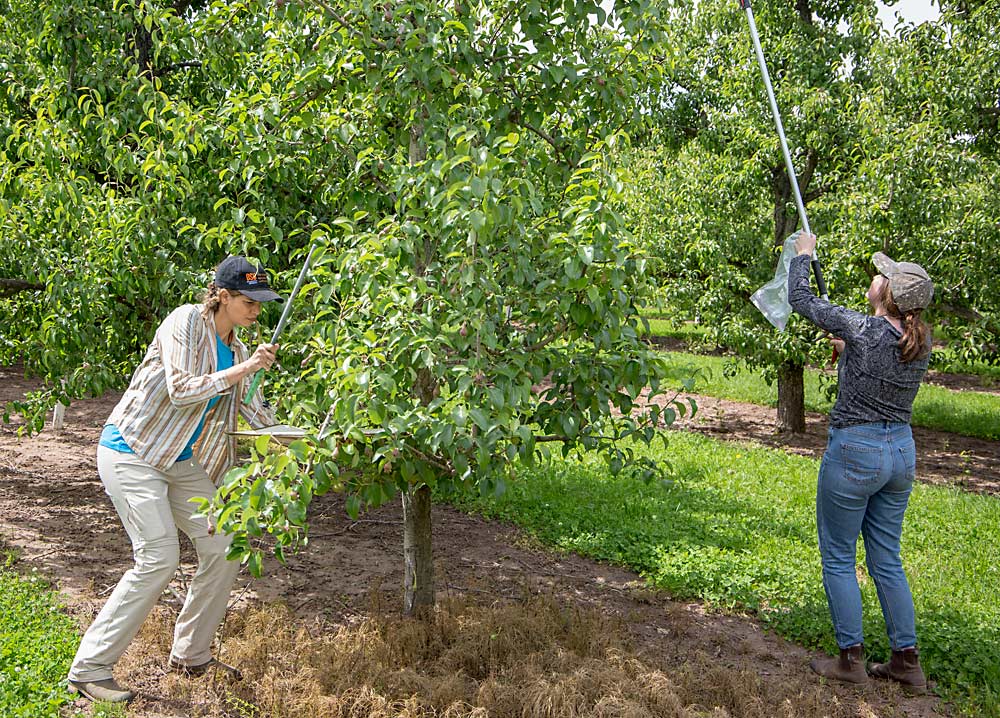
Oregon State University entomologist Dalila Rendon searches for trechnites and pear psylla mummies — psylla that have been parasitized by the beneficial wasps — in pear orchards in May 2018 in O’Dell, Oregon. (Ross Courtney/Good Fruit Grower)
The enemy of your enemy may be your friend, but what about all the other layers of enemies?
Turns out, there are hyperparasitic wasps attacking the trechnites, a parasitic wasp lauded for killing the dreaded pear psylla.
“The plot now thickens because the enemy of the enemy of your enemy is your enemy,” said Dalila Rendon, an Oregon State University entomologist studying several aspects of Trechnites insidiosus, a beneficial insect, usually called trechnites, that growers hope could become part of IPM strategies to control pear psylla, a pest that grows more troublesome each year.
The prevalence of the hyperparasites, which parasitize other parasites, were among a few surprise findings for Rendon and her colleagues during their yearlong study of the ecology of trechnites, a parasitoid wasp that lays its eggs in psylla nymphs.
They also came across evidence that the trechnites may scare away psylla simply by being present in the orchards.
“This has been probably the most fun project I’ve done,” Rendon said. “We got so much information from it.”

Rendon uses a beat tray to search for insects while Boyer takes vegetative samples. (Ross Courtney/Good Fruit Grower)
Rendon and her colleagues started with four relatively narrow objectives regarding the trechnites: determine their seasonal phenology, determine which plants they visit, study how much they parasitize and compare the effects of common insecticides.
Her one-year study was funded by a $31,000 grant from the Washington Tree Fruit Research Commission. She answered most of those questions, and more.
Back to those hyperparasites, or parasites within parasites; her team found at least two species — a figitid wasp and a pteromalid wasp — commonly emerging from psylla mummies, or parasitized nymphs.
But those species don’t attack psylla, according to previous literature. They lay their eggs inside of trechnites larvae developing inside psylla nymphs. Rendon likened the whole complex to Russian nesting dolls.
The good news is that the psylla dies because of the trechnites. The bad news is that the trechnites also dies before it can reproduce.
She believes this topic warrants more research. Some of her collaborators at the U.S. Department of Agriculture’s Wapato, Washington, laboratory may pursue grants along that line, she said.

Rendon and research technician Gabriela Boyer exit an orchard as Mount Hood looms in the background. (Ross Courtney/Good Fruit Grower)
Here’s a look at some of her other findings:
—In their parasitism capacity trials inside leaf containers, Rendon’s team found the presence of trechnites reduced psylla nymph survival to adulthood by 51 percent. But, they also found more missing nymphs when wasps were present, 14 percent compared to 4 percent without a wasp. Rendon suspects the nymphs squeeze out of their containers more often to escape an enemy, meaning the wasps may keep psylla from setting up shop on pear trees in the first place. Another theory is that when the wasps parasitize the psylla, they affect the host brain and prompt them to change their behavior and move, Rendon said. There’s precedent for that phenomenon in the parasite world.
—Of the insecticides Rendon’s team tested, Ultor (spirotetramat) was the safest for trechnites wasps because it killed the fewest adults in the trials. Agri-Mek (abamectin) killed the most adults, so she recommends making the first application before adults emerge. The trechnites larvae, protected inside the psylla mummies, were not affected by either insecticide, but showed mild negative effects from Esteem (pyriproxifen).
—Trechnites overwinter in the orchard as larvae inside psylla mummies. They are one of the first natural enemies to emerge as adults in the spring, usually in a dramatic burst. In Hood River, Oregon, that happens around the first week of May, at roughly 650 degree days; in Medford it happens in mid-June, at about 1,700 degree days. More research is needed to understand the spring ecology and predict its emergence, she said.
—The team found trechnites DNA in nymph mummies, even the empty ones left behind by the emerging hyperparasitoid wasps. The team will refine their method to be able to detect DNA of other hyperparasitoid wasps, as well, and understand what is parasitizing trechnites in the field. •
—by Ross Courtney






Leave A Comment